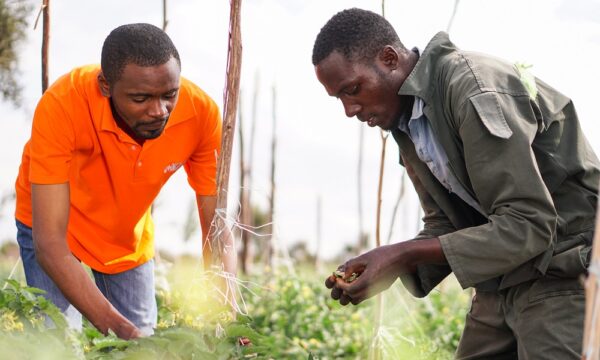
Tuta absoluta (tomato leafminer) larval damage on tomato (Lycopersicon esculentum). Photo: Marja van der Straten, NVWA Plant Protection Service, Netherlands.
The South American tomato leafminer, Tuta absoluta, is a devastating invasive pest of tomato crops in several areas around the world, including Africa where the problem is greatest. Given the wealth of research conducted on T. absoluta, a recent publication involving one of CABI’s scientists, Dr Marc Kenis, has compiled a comprehensive review of the current state of our knowledge and pinpointed important research areas for the future.
By reviewing over 150 papers on T. absoluta, the paper represents the most up-to-date account of this pest’s occurrence, biology and ecology, and provides an interesting and important discussion on its natural enemies, and the potential advantages and constraints of pest management scenarios adopted against this pest in both Northern and Sub-Saharan Africa.
With T. absoluta spreading rapidly, causing serious damages and substantial economic losses, it is vital that research continues and management efforts of this pest improve. In his paper, Dr Kenis and colleagues propose the following next steps for the sustainable management of T. absoluta:
- Further research into the genetic structure of T. absoluta in Africa, in order to determine the propensity of this pest to develop insecticide resistance. This is critical given that insecticide is still the most common management strategy for dealing with T. absoluta in Africa.
- A reduction in the over-dependence on synthetic pesticides and a push towards the use of insecticide compounds with a reduced resistance risk (those with plant extracts or microbial-based ones) and/or biorational alternatives.
- The further integration of insect-proof nets, pheromone-based tools, and indigenous biological control agents into pest management strategies.
- Further efforts to increase the implementation of sustainable management tools through, for example, the development of standard protocols or the promotion of local mass production of biopesticides to increase availability.
- Increased farmer and government awareness on the economic and environmental risks associated with the extensive use of pesticides, and the efficacy and sustainability of alternative tools.
Achieving these could lead to economically profitable and sustainable control systems which could increase the quality of the life of small farmers and of their families, the local consumers as well as the quality of the tomatoes grown for extra-Africa exports.
For more information on T. absoluta, please visit this species’ portal page on CABI’s Invasive Species Compendium.
Full paper reference
Mansour, R, et al. 2018. Occurrence, biology, natural enemies and management of Tuta absoluta in Africa. Entomologia Generalis. 38(2): 83 – 112.
1 Comment
Leave a Reply
Related News & Blogs
CABI highlights benefits of Pest Risk Analysis (PRA) support tools to fight invasive species in Caribbean
Larval damage CABI’s experts in the field of invasive species management have highlighted the benefits of the CABI Horizon Scanning (HS) Tool and CABI Pest Risk Analysis (PRA) Tool to help fight a range of invasive species in the Caribbean. Naitram Ram…
26 July 2022





Dear CABI,
We are pleased to see this wonderful picture of a Tuta absoluta larva on your blog.
However, we would be more pleased if you would credit the maker (Marja van der Straten, NVWA Plant Protection Service, Netherlands: see also https://www.ipmimages.org/browse/detail.cfm?imgnum=5431766)
best wishes, Antoon Loomans NVWA